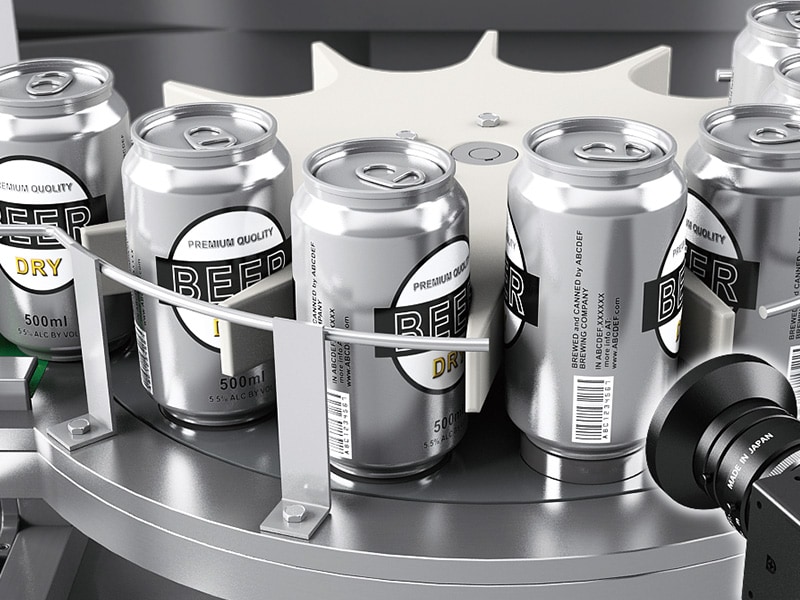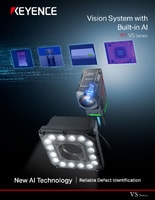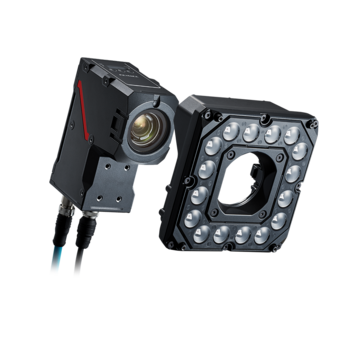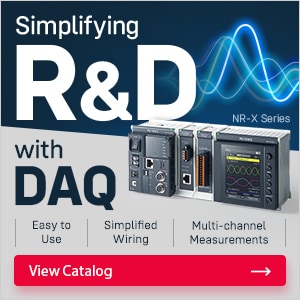Vision Systems
- Vision System with Built-in AI VS series
- Intuitive Vision System CV-X series
- Customizable Vision System XG-X series
- GigE camera and lighting for PC-based machine vision VJ series
- Inline 3D Inspection 3D Vision series
- 3D Vision-Guided Robotics 3D VGR series
- Line Scan Technology Line Scan series
- 2D Vision-Guided Robotics 2D VGR series
- LED Lighting CA-D series
- Lenses (for Machine Vision) CA-L series
- Machine Vision System Database VisionDatabase series
- 2D Measurement Inspection
- Optical Character Reading (OCR) and 1D/2D Code Verification
- Inline 3D Volume and Measurement Inspection
- Presence & Absence Inspection
- Flaw Detection
- 3D Vision-Guided Robotic Bin Picking
- High-Resolution Line Scan Cameras for High-Speed Imaging
- Automated Positioning and Alignment Systems Using Machine Vision
- Automotive
- Automation Equipment/Machine Building
- Electric Vehicles
- Medical Device Manufacturing
- Food/Beverage Packaging
- Semiconductor/Manufacturing Electronics
- Vision-Guided Robotics
- Solar
- Logistics
- Commodities
- Paper Manufacturing
- Machine Tools
- Electronic Device
- Printing
- Mining/Metals
- Fabric/Textile
- Tobacco
- Marine
- Aerospace
Ensuring Safe, Spotless Metal Packaging: Vision Solutions for Defect Detection

Metal food packaging remains a staple in the global food industry for its durability, shelf-life extension, and ability to withstand heat during sterilization. As production speeds rise and coatings evolve, maintaining consistent quality becomes more difficult.
Today’s food producers can’t afford to rely on outdated inspection systems. For operations focused on modern safety standards, vision systems offer a complete approach to metal packaging and defect control.
Why Metal Packaging Demands Rigorous Inspection
While metal packaging offers excellent protection, its vulnerabilities often emerge in the final stages of processing. Surface damage like scratches, dents, or delamination can compromise sealing integrity or leach material into contents. In some cases, flaws originate upstream, when metal fragments from worn equipment, cut wires, or foil residues slip into the process unnoticed.
Metal packaging in the food industry has long focused on identifying these contaminants. However, with reflective surfaces, overlapping labels, and rapid production speeds, conventional inspection tools struggle to keep up. This is especially true in aluminum or tin-lined packaging, where defect visibility can vary depending on lighting conditions, surface gloss, or label placement.
We’re here to provide you with more details.
Reach out today!

Common Defects in Metal Packaging
Metal food packaging can exhibit a wide range of issues, some structural, others cosmetic, and many invisible to the human eye at line speed. In high-volume runs, defects like improper forming, edge burrs, or misaligned seams often result from dull tooling or unstable feed alignment. Corrosion, another common concern, can originate from exposure to moisture or acidic ingredients, compromising the internal lining of cans.
Scratches, dents, and label tears affect presentation and can interfere with scanning or sealing. At this stage, relying solely on conventional inspection systems for food packaging leaves too much to chance.
Vision Systems as the Solution
Automated vision systems provide high-resolution, real-time inspection for metal packaging in the food industry, adapting to each product’s geometry and surface characteristics.
VS Series: AI‑Powered Detection
For lines requiring flexibility and minimal setup time, the VS Series offers a built-in AI engine trained to recognize defect patterns in real-world conditions. Operators don’t need programming experience to deploy the system; it’s designed to learn from product samples and detect variations that fall outside acceptable limits. The system excels in reflective or semi-gloss packaging environments, where traditional cameras often struggle.
Line Scan Cameras & 2D Vision Tools
When inspecting cylindrical or continuous surfaces, line scan vision tools are the best fit. These systems create a full, unwrapped image of each can’s exterior, capturing everything from seam misalignments to branding defects or illegible codes.
Discover more about this product.
Click here to book your demo.

Key Benefits for Packaging Lines
Vision-based inspection delivers much more than defect detection as it improves throughput by eliminating unnecessary manual checks and reducing slowdowns caused by ambiguous inspection outcomes. Systems like the VS Series handle variation without frequent recalibration, maximizing uptime.
For operations already investing in industrial metal detection systems for food safety, vision tools offer an extra layer of verification, especially for contaminants embedded in or obscured by packaging. Combined with practices like preventative maintenance and raw material screening, they help producers achieve more reliable inspections without compromising speed or efficiency.
Real‑World Application: Can Appearance Inspection
On fast-moving lines, even small dents on the side of a can can cause problems. Whether it's a seam deformation, a compromised surface coating, or a label shift that interferes with scanner readability, these defects must be detected before they reach downstream packaging or consumers.
KEYENCE line scan cameras deliver full-surface inspection for metal food packaging at high speeds. As each can rotates through the inspection zone, the system captures a continuous image that unwraps the entire circumference. Built-in edge detection and contrast tools help identify issues such as dents, print drift, or foreign material.
Best Practices for Deployment
Proper deployment starts with lighting. Glossy or curved metal surfaces require structured lighting setups to reveal distortions that flat light can hide. Alternating vertical and horizontal stripe lighting, similar to methods used in reflective plastics inspection, can significantly improve defect visibility. Structured lighting plays a key role in improving the inspection of shiny surfaces for metal food packaging. This is especially relevant when using AI-powered systems, which need clear visual contrast to differentiate between normal variation and actual defects.
Operators should also adhere to standard GMP protocols. Scheduled maintenance, debris removal, and avoiding metal tools or jewelry in inspection zones can reduce contamination risk before vision systems ever need to flag an issue. Where possible, integrating vision tools upstream with robotic palletizers and depalletizers further reduces handling-related damage.
The Final Seal on Defect-Free Packaging
In modern food production, staying ahead of regulatory and consumer expectations requires more than just basic detection; it demands full-surface, high-speed, intelligent inspection. Vision systems provide manufacturers with the visibility and reliability necessary to maintain high safety standards while maintaining efficient operations. Whether supplementing metal packaging defect detection or replacing manual QC entirely, these tools offer unmatched performance in identifying packaging defects before they become liabilities.
In food and beverage production, visual inspection tools now play a central role in maintaining quality. Unlike legacy methods, modern vision systems detect inconsistencies with greater precision and speed, without slowing down throughput.
Contact us to learn more about how our advanced technology can help take your business to the next level.
Contact Us
FAQs
Can Vision Systems Detect Defects on Printed or Reflective Can Surfaces?
Yes, systems like the XG-X and VS Series are designed to inspect reflective or printed metal packaging using controlled lighting and AI.
What Kinds of Defects Can These Systems Detect?
Dents, scratches, corrosion, seam misalignments, print defects, label issues, and surface contaminants.
How Fast Can These Systems Inspect Cans on a Production Line?
KEYENCE vision systems support high-speed lines and can inspect hundreds of units per minute with full-surface coverage.
Do I Need Programming Experience to Set Up a Keyence Vision System?
No, the VS Series is designed for fast, code-free setup by operators without specialized training.
We’re here to provide you with more details.
Reach out today!

Related Downloads
Related Products
Applications
- 2D Measurement Inspection
- Optical Character Reading (OCR) and 1D/2D Code Verification
- Inline 3D Volume and Measurement Inspection
- Presence & Absence Inspection
- Flaw Detection
- 3D Vision-Guided Robotic Bin Picking
- High-Resolution Line Scan Cameras for High-Speed Imaging
- Automated Positioning and Alignment Systems Using Machine Vision
Industries
- Automotive
- Automation Equipment/Machine Building
- Electric Vehicles
- Medical Device Manufacturing
- Food/Beverage Packaging
- Semiconductor/Manufacturing Electronics
- Vision-Guided Robotics
- Solar
- Logistics
- Commodities
- Paper Manufacturing
- Machine Tools
- Electronic Device
- Printing
- Mining/Metals
- Fabric/Textile
- Tobacco
- Marine
- Aerospace



